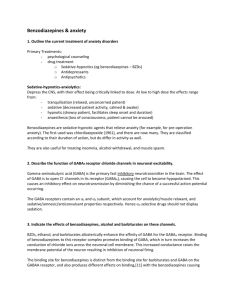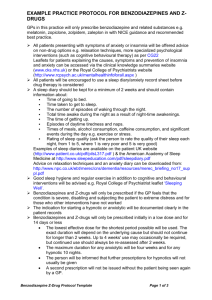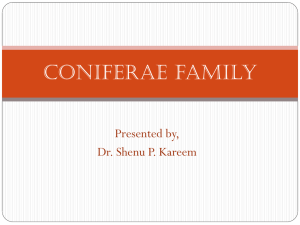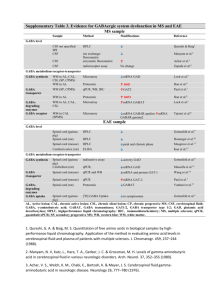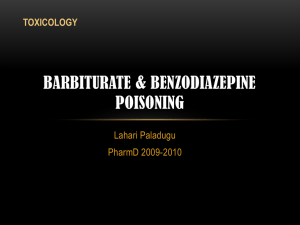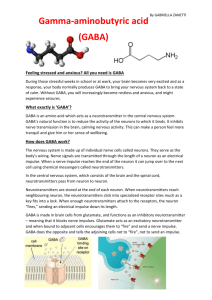Benzodiazepines
advertisement
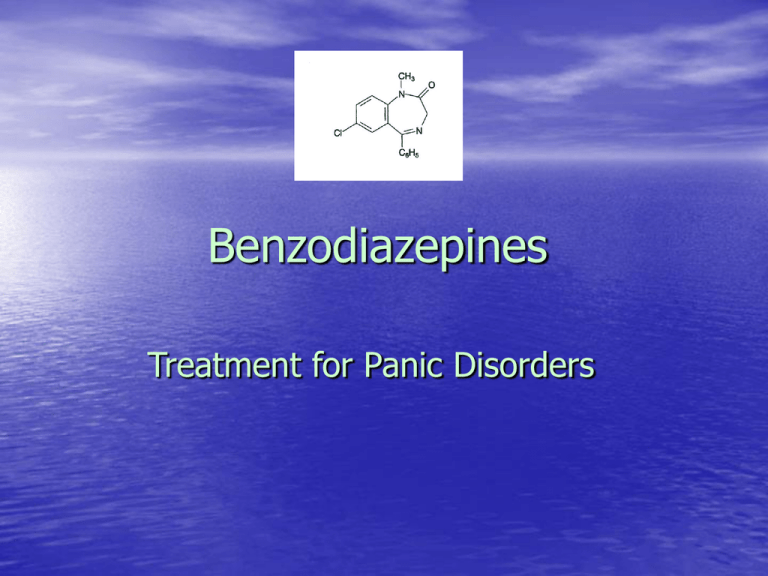
Benzodiazepines Treatment for Panic Disorders Why Benzodiazepines? • There is a great deal of • • research and a great deal of controversy Benzodiazepine is a class of anxiolytic compounds that can be subdivided into groups based on their halflife and potency Includes Xanax and Valium History • The discovery of Chlordiazepoxide as Valium was • • made by Leo Sternback in Poland during the 1940s Benzodiazepines were introduced to the general public in the early 1960s as tranquilizers. They were touted as something slightly less than a miracle drug. In the 1970s there was a strong public outcry because of its side effects and their use dropped by 25%. History • In 1985, 81 million prescriptions were filled in the US for • • • a total of 1.5 billion dollars spent (Michelson 1991) Despite its shortcomings and controversial notoriety it is still the most widely used anxiolytic compound today. (Gonzalea-Pardo 2006) 15% of the population has reported using this medication with a third of these reporting dependence on the tranquilizer. Approximately 2 % (3 million) of the population reports having taken the drug on a daily basis for over a year History • The majority of works published today regarding the use of benzodiazepines have to do with how to treat the dependency on the medication, and to a lesser extent, how it compares with talk therapies. Alprazolam in Panic Disorder and Agoraphobia: Results from a Multicentre trial James Ballenger • Most articles cite this particular research article as their base of information. • The article was published in 1988 by a team of 8 doctors and researchers working across North America and Australia. Study 1 • 526 participants began the 8 week , parallel-groups, double blind, placebocontrolled, flexible dose randomized study • The goal was to provide an empirical base on which other work could be founded. • The results gave Alprazolam widespread acceptance equal to that of tricyclic antidepressants and SSRIs Study 1 • Participants were administered an increasing dose of Alprazolam that reached 6mg/d and would not exceed a dose of 10mg/d • This dose was shown to produce the most effective results • Doses of 2-3mg/d were sufficient to effect some change in condition Study 1 • The parameters of the study strictly prohibited behavioral treatments during the 8 week period • But since 63% of participants had previously received psychiatric treatment, a substantial number of individuals began the study with some type of anxiolytic medication in their system Results Study 1 Limitations • A limitation to the study was that a • • • disproportionately large number of participants in the placebo group dropped out The results seem to indicate only a small effect, The individuals who did quit the study cited a lack of change as their motivation If all those who began had completed the study, the results would have been more distinct. Diazepam Versus Alprazolam for the Treatment of Panic Disorders • This study was conducted in 1995 by a team of 8 researchers, some of whom had worked on the previous study • Intends to compare Diazepam, a high halflife, less potent benzodiazepine with Alprazolam to validate the use of Diazepam as an anxiolytic compound Study 2 • The study examined the effects of both medications and placebos on 241 individuals who met the criteria for panic disorders • It lasted 8 weeks and was a parallelgroup, double blind, placebo controlled randomized assignment study Study 2 • Found effects similar to those in study 1 but 1. 2. 3. 4. the researchers addressed some of the limitations of the first study: They restricted patient use of other medications Permitted for a week long wash out period Had a more stringent screening process to eliminate comorbidity Based their dose on studies testing for the optimum dose Study 2 • It establishes Diazepam as a formidable • • treatment alternative, equally as effective as Alprazolam Limitation: -Despite their efforts, the dropout rate in the placebo group was equally problematic as in the first study. Some studies have reported attrition rates of up to 40% How Benzodiazepines work • These minor tranquilizers exert their effect by activating the inhibitory GABA receptors found throughout the nervous system. • They are an effective treatment for generalized panic disorders and have the ability to reduce the frequency of panic attacks • Tranquilizers have a receptor site • • • on the GABA mediated ion channels When a molecule binds to the channel, Chlorine ions are permitted to enter creating a hyperpolarization of the membrane Alcohol and barbiturates act similarly and so produce effects similar to those of tranquilizers. It is because of this morphology that mixing alcohol with the medication can result in an overdose. How Benzodiazepines work • Anxiety and panic disorders supposedly result from a lack of GABA neurotransmitters in the CNS, the limbic system and the occipital lobes. • Increasing the general GABA activity in the brain relieves the anxiety • There are three types of GABA gated channels: Subtype A, B and C GABA subtype A receptor complex • Most relevant to the treatment of panic disorders • Of the four GABA-sensitive receptor sites, the three ‘a’ sites are also sensitive to benzodiazepine How Benzodiazepines work • They work almost immediately, unlike the SSRIs which may require an extended period of time before their effects are appreciated • There is a high compliance rate with, and high tolerance for this therapy, unlike SSRI therapies • Very few patients are dissatisfied or do not respond to the medication Where’s the Problem? • 1. 2. 3. 4. 5. 6. The major pitfall of this therapy is that, since it works indiscriminately on all GABA receptors by increasing their activity, there are numerous side effects: Drowsiness Memory impairment Sedation Dizziness Shock related to drastic changes in dosage There is an elevated risk of coma or death if the medication is taken with other tranquilizers Side effects in humans Drowsiness Lightheadedness Dry mouth Depression Nausea, vomiting Insomnia Confusion Palpitations Nasal congestion Blurred vision 49.4 24.0 13.0 17.0 10.0 6.7 14.1 7.2 7.2 9.1 Side effects in animal models • Research done on rats has found that the 1. 2. 3. 4. 5. prolonged exposure to the medication can cause: Decreased birth weight by 7% Decreased litter size by 10% Decreased adult weight Increased liver and kidney size by 30 and 14% respectively Decreased prostate weight by 10% Dependence • A large number of those taking the drug become • • dependent after prolonged exposure With certain types of medication requiring multiple daily administration, withdrawal can become problematic as the effect of the medication wares off Much work has been done to examine the types of medication that can alleviate the symptoms of withdrawal Withdrawal • The main effect of withdrawal is serious rebound • • of anxious symptoms. When the therapy is abruptly discontinued, because the brain has developed dependency, there is a net decrease of active GABA receptors and a return of anxious feelings Treatments for withdrawal have concentrated on increasing the number of inhibitory receptors and increasing GABA production without running the risk of inducing seizures (a rarely but reported side effect of tranquilizer antagonists) Dosage • The risks related to dependence and withdrawal • • • • • make dose regulation very important Typically the dose will begin very low and will, over the course of a few weeks, increase to a level where overdose symptoms begin to appear. The dose is subsequently reduced Most research suggests that the effects are maximal at highest doses. But beneficial effects have been observed at low dose administration. Tolerance is developed to a certain extent but it does not become problematic Alternatives • Because of the vicious side effects, alternatives have been sought • Promising results come from medications already used for the treatment of seizures • These anticonvulsants work as well at the GABA gated channels but work only to increase GABA levels and do not work as agonists Selective GABAergic Treatment for Panic • This stud was conducted to evaluate and review the effectiveness of the anticonvulsants • Vigabatrin and Tiagabine work solely at the synaptic clef to increase GABA levels • In doing so it reduces the side effects associated with other tranquilizers. Study 3 • Anticonvulsants as an • • • alternative Work by preventing degradation and reuptake Tiagabine (TGB) inhibits reuptake Vigabatrin (VGB) inhibits degradation Study 3 • Though it is a review article, it presents • 1. 2. 3. specific points that boost our confidence in anticonvulsant therapies I believe that therapy with antiepileptic medication is the future: Benefits of benzodiazepines Few of the side effects Apparently no dependency Evaluation • Remarkable treatment both in its effectiveness and addictive potency: - Works to reduce the symptoms of panic and anxiety relatively rapidly - Is tolerated by most patients - But creates dependency and must be taken with care on a daily basis Evaluation • Prolonged use is problematic and so must be used in conjunction with other psychotherapies or pharmacotherapies • Yet some psychotherapists have refused to treat individuals taking the medications because of fears related to the overpowering effects of withdrawal Evaluation • A major concern is that individuals present • themselves with symptoms of anxiety yet do not disclose a history of alcohol abuse. This results in the prescription for a tranquilizer to treat the anxiety Almost half of the cases of anxiety reported to the Royal College of Physicians are related to alcohol or benzodiazepine abuse. ***** Further research • Because most of the benzodiazepines work • indiscriminately on all GABA gated channels it make sense to develop a compound with an affinity to act solely on GABA subtype A transmitters The development of a compound that does accumulate in the body and that does not metabolize as rapidly would reduce the severity of withdrawal symptoms and would reduce the frequency of administration
